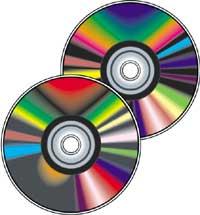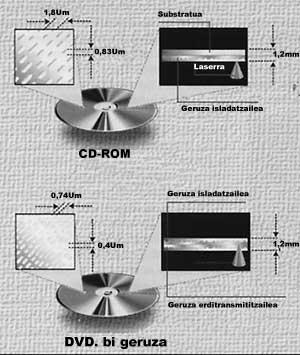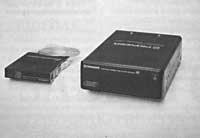The CD-ROM is dead, live the DVD!
1997/01/01 Susaeta, Tomasa Iturria: Elhuyar aldizkaria
It is the chilling speed of technology and innovations in the world of computing. The CD-ROM was born in 1985, began to be known among us in 1990 and is now fully extended. Enlargement has meant a decline: 370,000 sts/14,000 vols. The CD-ROM reader worked in 1991 with 150,000 pts./ /5,500 vols. and currently 30,000 sts./1,100 vols. only around.

In addition, the transfer speed of initial readers (passing data from the CD-ROM to the computer) was low, of 150 Kbps (150,000 bytes per second), but improvements were also initiated shortly: At the beginning of 1995, the four-speed ones were launched, in early 1996 the eight-speed ones and at the end of the year the 12-speed ones (1,800 Kbps). But the new technology is about to say goodbye, by the time this article is published it will be on the street, although it may take a few months to be discovered in the computer store of our city or town: The new album is called DVD and will soon be as well known as the CD-ROM.
What is that DVD?
Physically it will be like the CD-ROM, but for example, it can contain a film of 133 minutes of duration inside and it will have the sound quality Dolby Digital AC3 Surround (6 audio tracks), besides being able to listen to the film in 8 languages (the language that the user chooses). Not only that, in some sequences of the film the user will be able to change the view, the viewing angle. All this will be included in the DVD (“Digital Video Disk”), which is actually a high-density optical disc. The name is generic and from there a series of optical disc formats will be developed, that is, we will have a new word soup:
DVD-ROM: a data accumulation disk, such as the current CD-ROM, but large capacity. The CD-ROM has a capacity of 650 megabytes and the DVD will be able to store 4,700 megabytes on each side of the disc, which means a total of 9,400 megabytes, 14 times more than the CD-ROM, although they announce the publication of a two-sided but two-layered disk, with a total of 8,500 megabytes. The transfer speed of DVD readers will be 4.69 MB/s, which means 2.6 times the transfer speed of the fastest CD-ROM reader of the moment.
The DVD-ROM reader will connect to the computer and it seems that you can also read the current CD-ROMs (not the other way around: The DVD-ROM disk will not be read on current CD-ROM readers). Presumably you will also read the usual music CDs. However, it seems that the current CD-R disk, like the Kodak Photo CD, will not read, as the DVD uses a different laser color.

DVD-Audio: a disc specially prepared to save sound, such as current music CDs, but with a duration of 5 hours or more.
DVD-Video: a disc specially prepared to save movies that can replace the current video tapes. It has been announced that the video reader DVD-Video will be connected to television, as now the magnetoscope is connected to watch the video tapes. In addition, the DVD player can also read music CDs, but not CD-ROM or DVD-ROM. And always based on the information provided by the manufacturers, the format DVD-Video will not be able to be seen on the computer, that is, the movies will not be able to be seen on the computer screen, since it needs special video and audio decoders, very expensive today.
DVD-R to: disc that can only be recorded once and that follows the current CD-R. However, it seems that this type of album will not be released until 1997.
DVD-RAM: disk often erasable and rewrite. Although already announced, it is still in development phase and at least two years before seeing this album on the street.
Although the new album began to develop with the intention of becoming a video album, its possibilities have led inventors to remove the word Video and replace it with the word Versatile: Digital Versatile Disk, therefore. The Toshiba company was the founder of the new format and soon met with Philips and Sony in a similar project; in addition to these three giant companies, Pioneer, Thomson, Hitachi, Mitsubishi, Time Warner (portfolio) and others, the main companies in the sector, are developing the DVD.
Differences between CD-ROM and DVDThe difference lies in the disk structure. On the single-layer DVD disc the information points are closer to each other than on the CD-ROM disc: The frequency of the laser beam emitted by the DVD reader is higher, due to its lower wavelength, thinner, and focuses more specifically. Therefore, more information points can be entered on the same surface: the information points are closest to each other on each track and the nearest tracks. The double layer DVD disc (8.5 GB) consists of two layers to accumulate more information. In this type of discs, in order to focus the light beam on the lower layer, an intermediate layer is used to transfer the laser to the lower points. |

Gai honi buruzko eduki gehiago
Elhuyarrek garatutako teknologia






